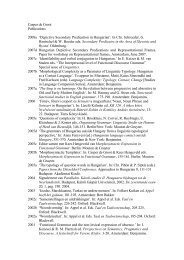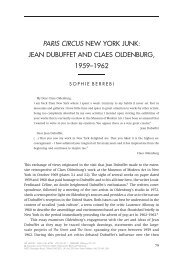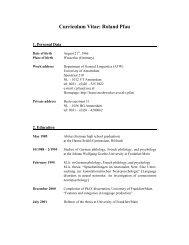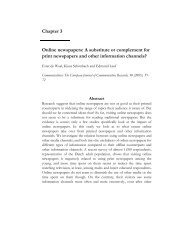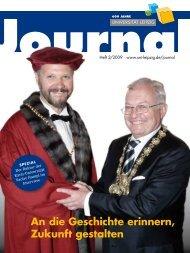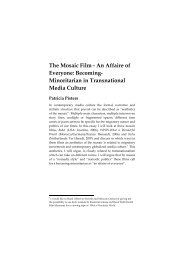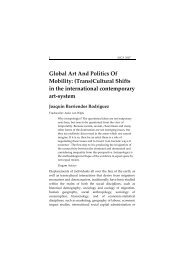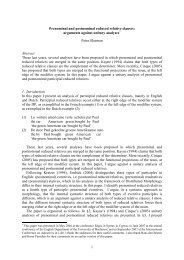Hyperdetermination in German Sign Language plurals
Hyperdetermination in German Sign Language plurals
Hyperdetermination in German Sign Language plurals
You also want an ePaper? Increase the reach of your titles
YUMPU automatically turns print PDFs into web optimized ePapers that Google loves.
Pfau & Ste<strong>in</strong>bach: Under-, over-, and hyperdeterm<strong>in</strong>ation <strong>in</strong> DGS <strong>plurals</strong><br />
→ Note f<strong>in</strong>ally that triplication – while be<strong>in</strong>g rare across spoken languages – is a common<br />
feature <strong>in</strong> the morphosyntax of sign languages. Various types of aspectual modification,<br />
for <strong>in</strong>stance, also <strong>in</strong>volve triplication (or even more repetitions).<br />
3 Underdeterm<strong>in</strong>ation with<strong>in</strong> DP<br />
→ Another <strong>in</strong>stance of underdeterm<strong>in</strong>ation concerns plural mark<strong>in</strong>g with<strong>in</strong> DP. In many<br />
languages, plural can be realized more than once with<strong>in</strong> DP. In the <strong>German</strong> example <strong>in</strong><br />
(14b) plurality is expressed on both the head noun and the numeral/quantifier.<br />
(14) a. Schiff → Schiff-e b. fünf/viele Schiff-e<br />
ship ship-PL five/many ship-PL<br />
‘ship’ ‘ships’ ‘five/many ships’<br />
c. * fünf/viele Schiff<br />
five/many ship<br />
→ In some languages, however, the head noun can only be marked for plural if the DP does<br />
not conta<strong>in</strong> a numeral/quantifier. Hence, plurality is only <strong>in</strong>dicated once with<strong>in</strong> DP, as<br />
e.g. <strong>in</strong> the Hungarian example <strong>in</strong> (15b) (see Ortmann (2000, 2004) for details and an<br />
optimality-theoretic analysis).<br />
(15) a. hajó → hajó-k b. öt/sok hajó<br />
ship ship-PL five/many ship<br />
‘ship’ ‘ships’ ‘five/many ships’<br />
c. * öt/sok hajó-k<br />
five/many ship<br />
→ Similarly, <strong>in</strong> DGS overt plural mark<strong>in</strong>g on L- and M-nouns is blocked whenever a<br />
numeral or quantifier appears with<strong>in</strong> the DP. This is illustrated by the examples <strong>in</strong> (16).<br />
(16) a. * FÜNF BUCH++ b. FÜNF BUCH<br />
five book:PL five book<br />
‘five books’ ‘five books’<br />
c. * VIEL KIND>+>+ d. VIEL KIND<br />
many child:PL many child<br />
‘many children’ ‘many children’<br />
→ Obviously, DGS does not permit the overt realization of the plural feature on the noun<br />
(i.e. triplication) when plurality is <strong>in</strong>dicated by a numeral or quantifier. Hence, DGS –<br />
just like Hungarian – lacks DP-<strong>in</strong>ternal number agreement.<br />
→ A similar observation is made for Israeli <strong>Sign</strong> <strong>Language</strong> by Stavans (1996). Note that for<br />
other sign languages it has been claimed that they do permit DP-<strong>in</strong>ternal numeral<br />
concord; e.g. Hausa SL (Schmal<strong>in</strong>g 2000) and Austrian SL (Skant et al. 2002).<br />
→ S<strong>in</strong>ce there is zero mark<strong>in</strong>g on the noun, we refer to the cases <strong>in</strong> (15bd) as<br />
“underdeterm<strong>in</strong>ation”. It might also be argued, however, that number mark<strong>in</strong>g on nouns<br />
<strong>in</strong> the presence of a numeral/quantifier is a case of overdeterm<strong>in</strong>ation.<br />
8






